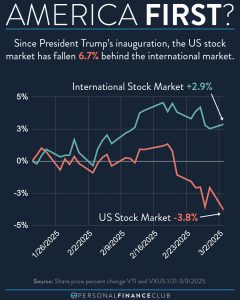

One of the biggest misconceptions I hear from newer investors is that they should be combining accounts in order to accelerate compound growth. For example, if they already have a 401k, they’re worried about putting money into a Roth IRA for fear that it will slow down their total portfolio growth. Why not just add more money to the 401k?
WELL, that’s not how the math works! Let’s walk through the example of Mike and Meghan. If the S&P 500 goes up by 10% one year, Mike’s smaller account goes up by $200 (10% of $2,000). His bigger account goes up by $800 (10% of $8,000). In total, that’s $200 + $800 = $1,000 gain for a total of $11,000. Meghan’s $10,000 account also increases by 10% giving her a total of $11,000 as well. So there’s no mathematical advantage to having fewer accounts.
HOWEVER, this assumes all things are equal. Different types of accounts can have costs and benefits. For example, your 401k might have higher expenses or less optimal investment choices. That might mean it makes sense to just contribute to your 401k up to your match, then put extra money into a Roth IRA. If you fill up BOTH of those, then go back to your 401k. And of course, you can always invest an unlimited amount of money in a plain old brokerage account which offers ultimate flexibility.
Rich people generally end up with lots of different accounts. I have two brokerage accounts, a 401k, a Roth IRA, an HSA, a 529. Not that my GOAL was to have all of these accounts, there was just a reason for each of them at the time. At the end of the day, carefully choosing which account to use is more “fine tuning” and even a little bit speculative based on future tax rates and things like that. What REALLY matters is putting more money in, so focus on that!
As always, reminding you to build wealth by following the two PFC rules: 1.) Live below your means and 2.) Invest early and often.
-Jeremy

 September Sale!
September Sale! 



